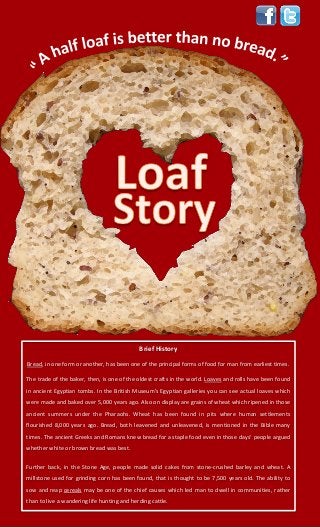
Loaf Story
- 1. Brief History Bread, in one form or another, has been one of the principal forms of food for man from earliest times. The trade of the baker, then, is one of the oldest crafts in the world. Loaves and rolls have been found in ancient Egyptian tombs. In the British Museum's Egyptian galleries you can see actual loaves which were made and baked over 5,000 years ago. Also on display are grains of wheat which ripened in those ancient summers under the Pharaohs. Wheat has been found in pits where human settlements flourished 8,000 years ago. Bread, both leavened and unleavened, is mentioned in the Bible many times. The ancient Greeks and Romans knew bread for a staple food even in those days’ people argued whether white or brown bread was best. Further back, in the Stone Age, people made solid cakes from stone-crushed barley and wheat. A millstone used for grinding corn has been found, that is thought to be 7,500 years old. The ability to sow and reap cereals may be one of the chief causes which led man to dwell in communities, rather than to live a wandering life hunting and herding cattle.
- 2. It started when… The baker mixes his dough-just the right amount of flour, water (which must be of the right temperature), salt and yeast. The mixture is left to stand in a warm place in its container or 'trough', and so to ferment and rise. When it has well risen, it is 'knocked back'. This means that it is thoroughly re-kneaded. The extra mixing helps to give it just the right degree of firmness, and also makes the yeast cells work harder and better. Then the knocked-back dough is left to stand, ferment and rise once more. When the dough has risen, it is divided into pieces of the right weight either by hand or machine. Another method of making bread dough is the 'no time' method. This is achieved by mixing the flour, water, salt and yeast together with a bread improver that accelerates the dough development and does not need the dough to be 'knocked back'. After dividing into pieces, and given a rest period the pieces of dough are molded into the loaf shape required. This can be done by hand or by a special machine. Next, the molded pieces of dough are put into tins almost, but not quite, ready for the oven. The dough must be given its last chance to rise before it reaches the oven, and here usually a pause of three-quarters of an hour is necessary. Then the loaves go into the oven for about three-quarters of an hour of baking. The dough soon becomes warm; the tiny gas bubbles expand until their 'walls' become firm, and so the loaf rises into its finished shape. The heat of the oven steams the inside and bakes the outside into a hard crisp crust. How attractive do the loaves look now, and what a lovely smell of new baked bread! Before the loaves can be sold, they must first be cooled slowly; to do so quickly would spoil the bread. After cooling, they are often sliced and wrapped before being sent to the Dispatch department and loaded into the baker's van. Many of the tasks in the bakery are now done by machine-mixing the dough, dividing, and moulding it into loaf shapes. Some of the larger plant bakeries have huge 'travelling' ovens, where the moulded loaves in tins are carried on a moving belt very slowly into and through the oven-dough as they enter baked loaves as they emerge the other end. We should remember, however, that the baker is a craftsman, with or without his machines, and has always been so.
